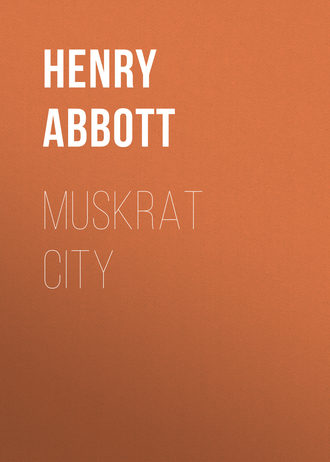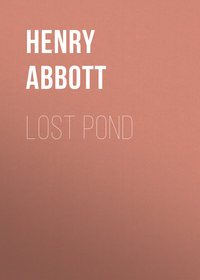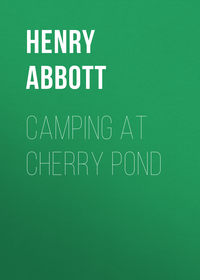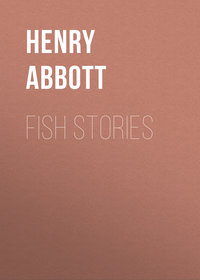 полная версия
полная версияMuskrat City
Another fellow prowled about our valley, though he lived on the ridges. He is larger than a marten and is also a handsome animal, but of a somewhat different type. He sometimes attains an extreme length of three and one-half feet and weighs eighteen or twenty pounds. He is known as a "fisher." Sometimes, also, called "black-cat" or "black-fox." The fisher is very ferocious and is feared by all animals not larger than himself. He is powerful and agile; the swiftest and most deadly of all the smaller forest carnivores. He will kill marten, mink, raccoon, muskrat, rabbit, and sometimes a fox. A fisher will attack a porcupine, tipping him over and biting into his stomach and the underpart of the body, where there are no quills. Nevertheless, fisher, when trapped, are often found with porcupine quills in the skin and in various parts of the body.
The fisher catches trout, and gets larger ones than would satisfy the mink, so he is no friend of ours. The fisher also is charged with the crime of following the trail of the trapper through the woods, robbing his traps and eating the animals caught in them. Bige vowed that he "would get that fellow next winter," and he "would get thirty-five dollars for his hide." (Now it would bring a much larger sum.) The proper procedure would be to set a second and larger steel trap, carefully covered and chained to a tree, but without bait, in such a position that when the fisher undertakes his high-handed game of robbery he will walk on and be himself caught in the second trap.
There was, of course, our old friend, the raccoon. He will find a camp anywhere, and if one is not careful he will find the camp larder and get away with the food. The coon has hands (fore feet) like a monkey, and he can use them as skillfully. The coon will eat anything a human will eat, and some other things. He takes his toll of frogs and trout, and he does not scorn the trimmings of trout we dress for our own table. Almost any kind of bait will do for the coon trap, and a coon-skin automobile coat will do for either man or woman having the price.
Red foxes seldom were seen in daylight at our city camp, though at night they were often heard barking. The fox is a very interesting animal and whether living in an open farming country or in the deep forest, he is credited with "living by his wits." By his acts he exhibits remarkable reasoning powers and adaptability to conditions that arise, though they may never before have been met. In the woods his food is similar to that of the marten, although he cannot climb a tree to capture his prey. The fox specializes on partridge and other birds that nest on the ground.
About a trap, the fox is very foxy. Tracks in the snow show when he has visited one, and he will usually succeed in springing a trap without getting caught in it. No matter how carefully it may be concealed, he can, and often does, pull the trap out, tip it over, spring it from the under side, then take out the bait. Every trapper has his pet method of circumventing this foxy trick. The favorite systems include the use of a second un-baited trap, which the fox is expected to step on while he is playing with the baited trap.
The dream and hope of the lifetime of every trapper is to some day catch a freak, black or silver grey fox; the skin of which commands a fabulous price. Such a catch would be like finding a gold mine. Of course, if these freak foxes were oftener caught, their fur would be less valuable.
The fact that, notwithstanding the number of trout eaters, including ourselves, who lived or roamed in our valley, there were still many trout in the streams, was to our minds conclusive proof that there were no otter in the neighborhood. An otter will clean the trout out of a brook in a few days. He will eat many and leave the rest dead on the bank, then move to another fishing place, ten or fifteen miles away. But there is no proof that an otter might not wander through this valley some time in the winter when the traps are set. The otter is a great traveler; also, in a fur store he is an aristocrat.
The varying hares, white rabbits, or snow-shoe rabbits, as they are variously designated, were plentiful in and near Muskrat City. They were often seen in the early dusk of evening, seldom in mid-day. They, in common with many small forest animals, are night prowlers. Doubtless for protective purposes, Nature provides this animal, like the deer and some others, with the faculty of changing the color of its coat with the change of seasons. When the snow falls in autumn, this breed of rabbit molts its brown summer fur and takes on a new coat as white as the snow itself. Again, when the snow melts and disappears in spring the varying hare sheds its white fur and acquires a new coat of brown for summer wear. The hind feet of this animal are exceptionally large, especially in winter when the long spreading toes are entirely covered with still longer fur, thus forming broad snow-shoe shaped pads which enable their owner to freely move about on deep soft snow. It is a curious fact that the tracks left in the snow by this animal show the large spreading prints of the two hind feet, placed ahead of the smaller imprints of the fore feet, which at the end of a lope always bring up in the rear.
When startled, this rabbit has the habit of rapidly thumping on the ground with its hind feet, making a dull drumming sound which may be heard for a considerable distance. This thumping also is said to be a signal employed during the mating season.
Several years ago I witnessed a fight between one of these rabbits and a domestic cat. The rabbit was a captive, enclosed by a tight fence in a pen about sixteen feet square, in one corner of which was a covered nest containing seven young rabbits. The cat had climbed into the pen and was trying to steal a baby rabbit, when the mother jumped on the cat's back and beat a rapid tatoo thereon with its hind feet, and doubtless with toe nails extended, as the air was filled with flying fur. The cat escaped over the fence, but for many days it went about with a sore back, unprotected by its normal coating of fur.
The snow-shoe rabbit is generally defenseless against its many forest enemies, and falls an easy victim to the trapper. It is a strict vegetarian in diet, and in its forest home does no harm to man or other animal.
The muskrats, who owned the city, however, were most in evidence. They held the center of the forest stage, and always secured the most attention. Perhaps this was because there were more of them in our valley than there were of any other animal. Possibly because the muskrat is the most numerous of any fur-bearing animal in North America. It is reported that in 1914 ten million American muskrat skins were sold in London. Of course, during the same year other millions were sold in the fur markets in various cities in the United States.
The muskrat has a compact body about twelve inches long from nose to root of tail. The tail is long, naked and scaly, slightly flattened vertically. It is used as a rudder in the water. The hind feet have short webs and are otherwise adapted for swimming. Its fur is fine and dense, interspersed with long, coarse hairs. Its color is dark umber brown, except on the stomach, which is grey. It has a musky odor due to secretions of a large gland. The muskrat is very prolific, usually having several litters of young in a season, totaling often as many as eighteen during a summer.
Muskrats feed on roots and stems of succulent water plants and other vegetables, varied with an occasional frog, fish, or fresh-water clam. A muskrat who lives near our cottage has the habit of opening clams and leaving the shells on our dock every night. The shells we are obliged to sweep off in the morning. "Musky" builds on the marsh, in the edge of a pond or near a stream, a curious cone-shaped house or lodge. He stores up roots and grasses for winter use, frequently building these in with mud into the walls of his house. Then in case of shortage of other food, he eats his house.
Bachelor or unmated muskrats sometimes dig holes in the bank of pond or stream, making the entrance under or near the water. Also, they sometimes build nests in tangled grass or a brush pile.
A muskrat skin brings to the trapper a smaller return in unit value than any other fur-bearing animal he captures. But he gets more of them, so if market conditions are favorable the total revenue from his catch is likely to be satisfactory. In the manufacture of fur garments, however, the humble muskrat holds an important place. In a fur factory, by the skillful use of tweezers for pulling out the coarse grey hairs, by the use of clipping and singeing machines, with the aid of dyes ("made in Germany") of various colors, his skin is effectually disguised and it emerges therefrom not only in larger numbers than the skins of any other four-footed beast, but completely transformed in appearance, and masquerading under more different aliases than are permitted to all the other fur animals combined.
For example, the former resident of Muskrat City might appear in the showroom of the fur dealer as "river mink," "mountain marten," "valley sable," "spruce beaver," "brook fisher," "domestic raccoon," "hillside fox," "fresh-water otter," "Hudson seal," etc., etc. Also, sometimes he does good service under plain "muskrat."
During many seasons since our first visit trappers have taken from their backs the coats of many residents of Muskrat City. These have been transformed and now, in cold weather and in hot weather, cover the backs of women in other cities. Also, their four-footed neighbors have captured and eaten many muskrats; nevertheless, the colony seems to be just as numerous as when we first knew it.
The snows of twenty winters have fallen in the forest since Bige and I put Muskrat City on the map, and since we built the camp on the hillside above it. Other trappers have followed Bige's trail through the woods and have taken their toll of the inhabitants. But I am confident that if a census were taken today, it would be found that in population Muskrat City is holding its own quite equal to some of the cities in Iowa.
Doubtless it is a wise provision of Nature that those animals, birds and fishes which are most killed and eaten by others are made most prolific. Such thinning of their ranks may be necessary to avert famine, disease or some worse disaster among them. In view of their many predatory enemies, not forgetting the human killer of fish, it is marvelous that any trout of legal size are found in a brook.
Noises of the forest night are always interesting. While the camp fire burns, the forest people in its immediate vicinity are generally quiet. The fire is an unusual experience for them. It attracts them. They are fascinated by it, as are small boys by a circus, and while it burns they are likely to suspend their usual occupations and watch the flare and flicker of the blaze and the weird shadows it casts. Many of the less timid may approach quite near, others more wary will circle quietly and cautiously about at a considerable distance but always in view of the fire. If there should happen to be a light fall of snow on the ground the tracks visible in the snow in the morning will disclose the names of the visitors at the camp fire.
Later at night, however, when the fire has died down, and is no longer visible, one's forest neighbors will resume their usual occupations, and the wakeful camper may listen to the patter of hurrying footsteps, to the scratch of toe-nails on bark as a climber goes up or down a tree trunk, to the sniff of the inquisitive fellow who smells about the camp, to the chatter of the chap who talks to himself, to the loping or jumping noises, to the splashes in the brook, to the last despairing cry of some small animal as his life is being crushed out by his captor. A deer, softly stepping along his beaten path which leads down the valley to a pond where he goes every night for drink, for water plants, or just to wallow, may encounter a breeze bringing to his nostrils the human scent. He then will blow his bugle blast, which can be heard a mile. In such case the wakeful camper is never in doubt as to who spoke. The same is true when the owl booms out across the valley his eternal question, "Who?" No other bird or beast ever speaks in the same tone of voice. But most of the smaller noises of the forest night are subjects for speculation. One always instinctively tries to analyze and allocate each noise to its author. In this game an intimate knowledge of the habits of forest residents is useful, so that, at the camp breakfast in the morning, one may confidently assert that so and so visited the camp last night!
When, as sometimes happened, both Bige and I were wakeful at the same time, the breakfast hour was made interesting by differing opinions, and discussions over the habits and identity of our noisy neighbors. There are, of course, many birds and a few animals who sleep at night, and are met with only in the daytime. These were not considered in our discussions.
One night at Muskrat City, both Bige and I were suddenly awakened by most unusual sounds coming from the direction of the hillside across the valley. Bige sprang up to a sitting posture, exclaiming, "Sufferin' Cats! Did you hear that noise?" I did; and expressed the opinion that "the suffering of the cats was acute." Immediately, the sounds were repeated, if possible louder than before. It would be difficult accurately to describe those sounds. We were reminded of disputes we had heard, in the back yard, between two Thomas cats, whose wordy arguments over their respective claims to "Mariah" often ended in scratching and hair-pulling. I, however, never met any tom cat who could produce one-tenth of the volume of noise that came across that valley.
There were two voices, one a little higher pitched than the other, and both talked at once. Beginning in a low-toned complaining wail like the last despairing cry of a lost soul entering perdition, remarks would follow each other in crescendo volume, and in ever increasing rapidity, epithets would be fired by the contestants until the snarling, sarcastic statements were fairly spat out, ending in shrieks that could be heard miles. After an interval of a few seconds during which the disputants seemed to have changed their positions, the argument was renewed, proceeding as before except that with each repetition the anger and violence of the scrappers increased. At the height of one of these tirades there was heard the scratching and tearing of toe-nails on bark as one wordy fighter seemed to chase the other up the trunk of a tree and through the branches. This was quickly followed by two thuds as of one heavy body after another striking the ground, then the breaking of sticks, the rustle of leaves and brush as the two animals raced up the steep hillside. The race was punctuated by snarling, snapping sounds, which died away in the distance as the language fighters passed over the ridge until the sounds finally became inaudible. It was a dark night, and at no time did we get a glimpse, even indistinctly, of the scrappers. We are still speculating and wondering who or what they were.
This story has been told to many hunters and trappers familiar with Adirondack forests. Opinions have been sought as to the probable identity of these belligerent animals. So far, no plausible or reasonable suggestion has been made. Some of the old-timers say the tale reminds them of experiences of fifty or sixty years ago, when the bay-lynx, bobcat or wild-cat made these woods and mountains their home and hunting ground; but they have been exterminated. None of these cats have been seen for more than a generation.
Neither Bige nor I are acquainted with any animal capable of making the particular kind of noise we heard that night at Muskrat City. Our suggestion is, that possibly the wild-cats have come back.
One winter an unusual number of snow storms occurred, following each other in rapid succession until there was an accumulation of snow over five feet deep throughout the forest and on the roof of our camp at Muskrat City. This was followed by rain and freezing weather, turning the snow into ice. The great weight of ice and snow proved too heavy for the roof and it was broken down. In the following spring a large maple tree fell across the camp and crushed it into a tangled, shapeless wreck. Our log camp at Muskrat City has disappeared, but as a memory it shall remain forever!
END OF MUSKRAT CITY







